The Importance of Communicating About (Nuclear) Science
Brookhaven scientists organize communications session and panel at Institute for Nuclear Materials Management annual meeting
August 14, 2019
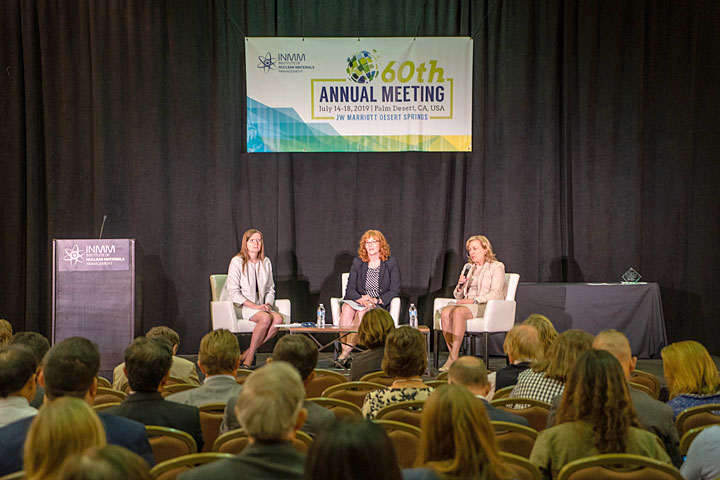 enlarge
enlarge
Susan Pepper, chair of the Nonproliferation and National Security Department at Brookhaven National Laboratory and current vice president of the Institute for Nuclear Materials Management (INMM), left, at this year's INMM annual meeting with Tammy Taylor, Director, International Data Centre Division, Comprehensive Test Ban Treaty Organization, and Therese Renis, Director, Division of Safeguards Concepts and Planning, International Atomic Energy Agency.
Communicating about science is a challenge. Bridging the gap between conversations with colleagues immersed in the language of the laboratory and audiences ranging from educated and curious to uninterested or even distrustful can be daunting. Add to that the potential consequences of miscommunication—particularly in high-stakes fields like nuclear materials management and nonproliferation, where political, safety, and security issues exacerbate the task—and some scientists might be tempted to run from the microphone.
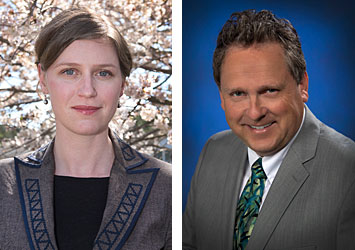
INMM communications session and panel co-chairs Martin Schoonen and Kate Bachner, both of Brookhaven National Laboratory.
But Susan Pepper, Chair of the Nonproliferation and National Security Department at the U.S. Department of Energy’s Brookhaven National Laboratory, recognizes that clear communication is essential to achieving objectives within and beyond her field. She’s currently serving as vice president of the Institute for Nuclear Materials Management (INMM)—an international nonprofit technical organization of engineers, scientists, technicians, policymakers, analysts, and others engaged in operating reactors; tracking, transporting, and disposing of nuclear materials; and ensuring nuclear safeguards and security around the globe. To assist INMM members in understanding the importance of strong communication skills, provide them with tools to improve their abilities, and discuss the ever-changing array of communications opportunities and platforms, Pepper and colleagues organized a session and panel devoted to communication at the INMM annual meeting in Palm Desert, California, July 14-18.
“We wanted to explore the challenges and opportunities associated with communication within and beyond INMM,” Pepper said. “For the panel, we brought together speakers from a variety of fields who are responsible for (or coach others in) communicating technical information with the public, peers, government representatives, and elected officials to share their experiences and good practices.”
Martin Schoonen, Brookhaven’s Associate Laboratory Director for Environment, Biology, Nuclear Science & Nonproliferation, chaired both the session and the panel discussion, with Katherine (Kate) Bachner, leader of the Lab’s Nonproliferation Policy and Implementation Group, serving as co-chair.
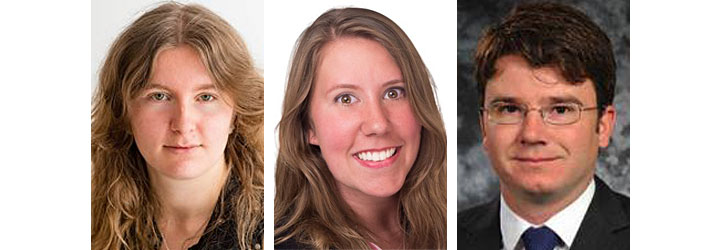
Communications session presenters Zenobia Homan (Kings College London), Megan Porter (IAEA), and Jay Disser (Idaho National Laboratory).
As a science writer with 20 years of experience in Brookhaven Lab’s Media & Communications Office, I was invited to serve on the panel to share tips for telling stories, translating technical language, and insight into the many benefits of communicating beyond the Lab—which include building support (possibly even funding) for research, and inspiring next-generation scientists.
I was impressed with the importance placed on communication, not just in these dedicated communications sessions, but throughout the INMM meeting. In talks on topics ranging from integrating the technological tools of “nuclear security” with the people who use those tools, to the ways nuclear energy is portrayed in discussions about climate change, the theme of communication kept coming up.
In both the dedicated talks and other sessions, speakers emphasized that communication is essential to building trust and ensuring understanding across a range of cultures—including industry, government organizations, the public, and more. But the discussions went beyond analyzing the messages going out to include whether and how various audiences receive those messages—and whether they act upon them in ways relevant to their jobs, or by altering their beliefs or behaviors.
“The importance of clear communication when dealing with nuclear reactor safety and security is obvious to all, but it is a challenge to convey a consistent and clear message given differences in culture and language among the target audiences,” said Schoonen. “These sessions allowed us to explore a number of perspectives on this issue.”
Dedicated session presentations
As Zenobia Homan of the Centre for Science & Security Studies at Kings College London explained, the challenges of clear communication arise not only from the complexity of scientific concepts but also from the many different languages used in the international arena of nuclear materials management. Even words as seemingly simple as “safety” and “security” can cause confusion because they are defined, understood, and translated differently across the world. In fact, many languages don’t have separate words for these concepts, which can possibly refer to protecting people, the environment, nuclear installations, or materials—or all of these. Homan described studies she’s conducting to illuminate these linguistic and conceptual differences and their impact on comprehension and behavior. She noted how adding contextual information can help to clarify meanings.
Megan Porter, an Information Officer who primarily handles internal communications for the Department of Safeguards at the International Atomic Energy Agency (IAEA), faces the classic challenges of translating technical terms and concepts and lots of acronyms—plus the added need to maintain the confidentiality required of the IAEA’s work. She presented results from a recent internal survey showing that Department of Safeguards’ staff felt communications were improving, and that 83 percent now believe communication is part of their job. Her group is introducing new ways to connect people across different Safeguards Divisions and between IAEA departments. One new approach is the use of “skip-level” meetings that bring higher-level managers into more direct contact with subordinates, which is already improving internal departmental communication. In turn, good internal communications can lead to improved communication with IAEA’s external audiences, she said.
To strengthen its own internal communications—and recruit new members—INMM produces an electronic publication known as the INMM Communicator, currently co-edited by James (Jay) Disser of Idaho National Laboratory and Brookhaven’s Kate Bachner, who hold these positions as volunteers in a volunteer-led organization. “We disseminate information, but it’s also important to have bidirectional communication,” said Disser, as he described the publication’s evolution over time. “We want to serve as an outlet for members to promote their work to other members, and shine a spotlight on other chapters—including outside the U.S.” The publication’s current incarnation as a web-based blog has been a manageable way to produce timely articles, and it provides easy access to archived content, he said. But like all communication efforts, it takes time and work.
A panel of outreach ideas
Presenters throughout the communications session and on the panel emphasized that to make the work of communication pay off, it helps to tailor messages and stories to a particular audience.
“Define your target group and start with their needs, not your own messages or solutions,” said Elina Martikka of the Finnish nuclear regulatory agency, STUK. This emphasis on stakeholder feelings, or empathy, extends even to the STUK logo, which incorporates a subtle representation of a heart, she said, to convey that the organization cares about people and the environment.
Working with the science communicators in institutional public affairs offices can help scientists develop skills to share their work more effectively. The process we use at Brookhaven to write news releases and feature articles for the Lab’s official communications channels usually starts by having a conversation with a scientist.
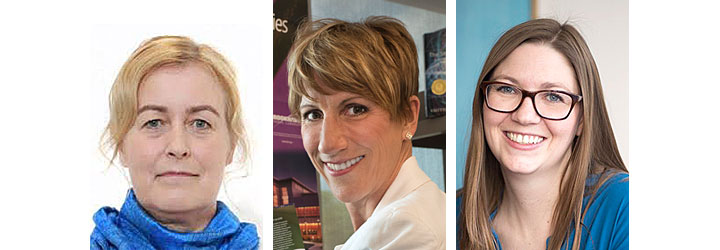
Communications panelists Elina Martikka (STUK), Karen McNulty Walsh (Brookhaven Lab), and Suzanne Hobbs Baker (U. Michigan).
In these interviews, we coach scientists to identify the news and why it matters—particularly to an audience beyond the Lab—and to tell that part of the story first. Providing this big-picture context for even the most incremental research findings—and describing the work with vibrant, active language—can capture readers’ or listeners’ attention and give them a reason to care.
To back up this assertion, I shared findings from a research paper I’d read on the science of science communication just prior to the conference. It stated that presenting research or any information in a way that resonates with your audience’s interests will be more likely to trigger the biological processes of memory that enable listeners to incorporate new ideas and overcome preconceived notions.
Conversations should be shared experiences rather than one-way lectures, with room for questions that can guide where the story goes. “Listen for understanding, not only answering,” Martikka said.
Suzanne Hobbs Baker, now at the University of Michigan, described a wide array of efforts to promote public engagement and nuclear literacy throughout her career, including stints at Idaho National Laboratory and the Department of Energy. Her projects have included the use of art installations, hands-on science activities, and other ideas for bringing benefits of scientific opportunities to communities, and “pulling” community members in as visitors, participants in facility designs, and members of the workforce.
By making contributions to the community—not just economic ones—these programs build a foundation that helps balance risks perceived or real, Baker said.
Martikka likened this process to depositing pennies in a piggy bank every single day to build up trust. You can draw on that investment when needed, but if you don’t build it up over time, you cannot create trust overnight, she said.
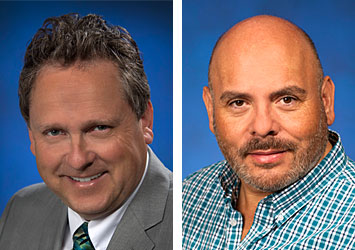
Martin Schoonen and Alejandro Sonzogni of Brookhaven Lab presented scientific research papers at the INMM meeting.
Brookhaven Lab actively engages this idea through our Summer Sundays tour program, myriad educational opportunities, and outreach programs like PubSci. Brookhaven Lab’s Community Advisory Council has also played a critical role in fostering open communication and trust with stakeholders important to the Lab.
As Bachner noted, “One of the fascinating aspects of this communications panel was addressing how communication goes beyond the traditional science and policy discussions. The nuclear community—those involved in energy policy and safeguards—needs to be more effective at engaging beyond the narrow realm of experts who speak our jargon,” she said.
“Understanding that communication is bigger than just understanding science and discussing it with subject-matter experts is absolutely necessary for all of us to fulfill our goals—of making the world safer, more secure, and of ensuring a sustainable, carbon-neutral energy future for all.”
Women of Mass Distinction
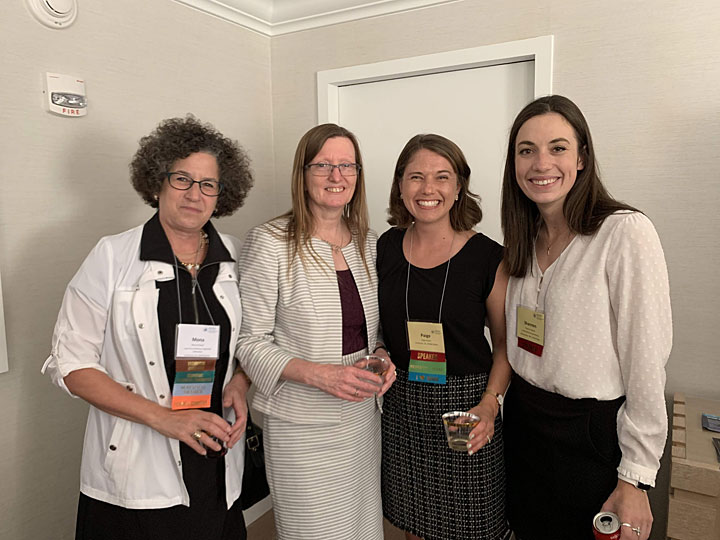 enlarge
enlarge
Susan Pepper, second from left, at the "Women of Mass Distinction" reception with Mona Dreicer and Paige Gasser (both of Lawrence Livermore National Laboratory) and Shannon Abbott (Sandia National Laboratories), right.
Another impressive element of the INMM meeting was the presence of so many prominent women. INMM partners with a leadership network known as Gender Champions for Nuclear Policy, which aims to break down barriers and increase the visibility of women. INMM’s current president, Cary Crawford, has a policy of not participating on any panels that are single gender, and the INMM as a whole has committed to having gender balance among annual meeting speakers and on the slates of candidates seeking election to organizational positions.
Pepper, who has been an INMM member since 1993, has served in various roles, including vice president, president, and past president of the Northeast Chapter, secretary of the Vienna Chapter, member-at-large of the international organization, and awards committee chair. As current INMM vice president, she will begin a two-year term as president in 2020, and serve as past president starting in 2022.
As part of her effort to recognize and elevate women in the organization, she hosted an informal “Women of Mass Distinction” networking reception the evening of July 15.
“Our past-president, Corey Hinderstein, started ‘WMD’ in 2017, and I was happy to have the opportunity to host the event this year,” Pepper said. “The INMM members appreciate the opportunity to gather in support and recognition of women’s contributions to nuclear materials management.”
2019-16699 | INT/EXT | Newsroom









